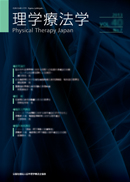All issues

Volume 34, Issue 7
Displaying 1-4 of 4 articles from this issue
- |<
- <
- 1
- >
- >|
Research Reports
-
Masafumi ARAO, Noriyasu KINODA, Taizo SHIOMIArticle type: Article
2007Volume 34Issue 7 Pages 279-285
Published: December 20, 2007
Released on J-STAGE: August 25, 2018
JOURNAL FREE ACCESSThe purpose of this research was to verify the reliability and validity of a Multi-Directional Reach Test in patients with stroke. Subjects were 24 hemiplegic patients after stroke (average age 55.5±11.7 years old). Reach motions were measured with the Functional Reach Test (FRT), Multi-Directional Reach Test (MDRT), and the Four Directions Functional Reach Test (FFRT) that the authors designed. The features of FFRT are accomplishment with a single hand, and frequent movements of ADL. The reliability evaluation used the intra-class correlation coefficient ICC (1.1), and high reliability was indicated for each test (ICC=0.91〜0.99). As to the examination of validity, the center of pressure excursion (COPE) was measured with a stabilometer. Moreover, the Timed Up and Go Test (TUG) and the walking independence level were measured as indexes of the walking ability. COPE correlated with FRT (r=0.78), MDRT (r=0.42〜0.78) and FFRT (r=0.58〜0.78). TUG correlated with FRT (r=-0.42), MDRT (r=-0.55), and FFRT (r=-0.52). At the walking independence level, significant differences were seen in FFRT. In conclusion, FFRT is available as a multidirectional reach test for the patients with stroke, because it reflects COPE and the walking ability.View full abstractDownload PDF (1169K) -
Ryou YONETSU, Osama NITTAArticle type: Article
2007Volume 34Issue 7 Pages 286-293
Published: December 20, 2007
Released on J-STAGE: August 25, 2018
JOURNAL FREE ACCESSThis research attempted to obtain an objective evaluation index by utilizing “patternizing” standards on standing up movement of subjects with cerebral palsy. The subjects were fifty-one spastic diplegia (SD) patients aged from 3 years and 2 months to 17 years and 4 months, mean age of 9 years and 11 months. The control group consisted of ten healthy children aged from four years and 5 months to 11 years and 10 months, mean age of 7 years and 2 months. First, movements of subjects (SD and control groups) from sitting position to standing were captured from the side with one digital video camera. Next, these standing up movements were classified into two phases, and the state of the extremities was evaluated by 15 items. Based on these 15 items, characteristic movements were identified and recorded as YES or NO. Finally, using SPSS (version13), cluster analysis was conducted. Subjects' standing up movements were classified into six groups. From these findings, it was possible to distinguish the characteristics and differences of standing up movement in healthy children and SD subjects. Moreover, the SD subjects were also able to be classified into five groups based on their shared characteristics of standing up.View full abstractDownload PDF (996K) -
Hideaki SASAKI, Junji KATSUHIRA, Hitoshi WATANABE, Fumiyo SAIJOU, Akih ...Article type: Article
2007Volume 34Issue 7 Pages 294-301
Published: December 20, 2007
Released on J-STAGE: August 25, 2018
JOURNAL FREE ACCESSThe purpose of this study was to determine the effects of using assistive devices on low back load during transfer movement in efforts to reduce the physical load of the caregiver. We compared low back joint moment, knee and trunk angle, floor reaction force and Borg scale for three types of transfer: without transfer aids, with a transfer board, and with a transfer belt. Among the three transfer types, use of the transfer board showed significantly smaller Borg scale values, backward low back joint moments and vertical components of floor reaction force. These results indicated that low back load differed according to whether or not the caregiver bore the weight of the persons being transferred, suggesting that the use of a transfer board may decrease low back load of caregivers during transfer.View full abstractDownload PDF (1469K)
Case Study
-
Toru OKA, Hiroshi KUROKI, Yasuyuki MIZUNO, Taizo FURUKAWA, Yasuaki NAK ...Article type: Article
2007Volume 34Issue 7 Pages 302-307
Published: December 20, 2007
Released on J-STAGE: August 25, 2018
JOURNAL FREE ACCESSRecently, osteochondral transplantation (mosaicplasty) has been widely used to treat patients with articular cartilage lesions. Although many studies have reported that this transplantation successfully replaces the cartilage lesion with intact hyaline cartilage harvested from a donor site, no report has focused on physical therapy programs after transplantation. The lesion sites and size of the transplantation are quite different in each case. Therefore, different physical therapy programs should be planned for each case. In the present case, we report a specific postoperative physical evaluation and therapeutic exercise program. It is important to devise a program which takes into consideration the position and pressure on the contact surface of the transplantation for knee cartilage lesions, and also one which pays attention to knee joint angle in muscular strengthening exercises and weight bearing exercises.View full abstractDownload PDF (1019K)
- |<
- <
- 1
- >
- >|